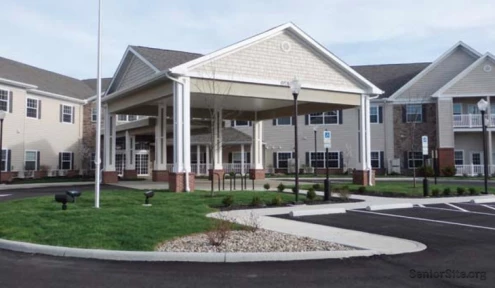Baby Boomers own life insurance at higher rates than any other generation, with 57% having senior life insurance coverage according to LIMRA’s 2024 Insurance Barometer Study.
Seniors typically purchase life insurance to cover final expenses, pay off remaining debts, replace income for surviving spouses, and leave a legacy to family members. The costs vary considerably by age and gender. A 70-year-old woman pays approximately $2,361 annually for a $500,000 term policy, while a man of the same age pays about $3,749 for identical coverage.
U.S. News evaluated 18 life insurance companies to identify the best options for adults over 60. This review examines top providers including Guardian, MassMutual, and other industry leaders, focusing on their coverage options, pricing structures, and specific policy features for adults aged 60-85.
MassMutual
MassMutual stands as a cornerstone in the senior life insurance market, with a heritage dating back to 1851. The mutual company’s 170+ years of experience has built a reputation for reliability and financial strength that particularly appeals to older adults seeking coverage.
MassMutual senior life insurance policy options
MassMutual’s whole life insurance accepts applicants up to age 90, making it accessible for older seniors. Coverage starts at $25,000, providing affordable options for those primarily concerned with final expenses. The company places no cap on whole life coverage, giving seniors flexibility for larger financial protection needs.
Beyond whole life, MassMutual provides:
- Term life insurance: Available for ages 18-75 with terms of 10, 15, 20, 25, or 30 years and coverage starting at $100,000
- Universal life insurance: Accessible to those 18-85 with coverage starting at $50,000 and flexible premiums
- Variable universal life insurance: Offers investment options with tax-deferred growth
MassMutual’s policies can be customized with riders including accelerated death benefit, waiver of premium, guaranteed insurability, and long-term care access options.
MassMutual pricing for ages 60-85
MassMutual doesn’t offer quick online quotes, requiring potential policyholders to contact an agent for precise pricing. Rates vary based on coverage type, death benefit amount, age, and health factors.
Older buyers, smokers, and those with preexisting health conditions typically face higher premiums. Some Reddit users note that MassMutual’s policies aren’t the cheapest but consider them worth the higher price for their reliability and benefits.
MassMutual pros and cons for seniors
Pros:
- Accepts applicants up to age 90 for whole life insurance
- Exceptional financial strength ratings from all major agencies
- Remarkably low complaint index of 0.03 in 2023, far below industry average
- Ranked third in customer satisfaction in J.D. Power’s 2024 study with 809 out of 1,000 points, exceeding the industry average of 790
- Cash value in whole life policies grows with high interest rates
Cons:
- No final expense-specific insurance products
- No online quotes available – must work with an agent
- Generally higher premiums than some competitors
- Limited online self-service options for older, less tech-savvy customers
MassMutual dividend payouts and financial strength
MassMutual’s dividend history remains one of its most compelling advantages for seniors. The company has paid dividends to eligible policyholders every year since 1869, establishing a 157-year track record of consistency.
For 2025, MassMutual has announced its largest dividend payout in company history at more than $2.50 billion, with an increased dividend interest rate of 6.40%. This represents significant value for participating policyholders, particularly those with whole life insurance.
In terms of financial stability, MassMutual maintains ratings among the highest of any company in any industry:
- A.M. Best: A++ (Superior)
- Fitch Ratings: AA+ (Very Strong)
- Moody’s Investors Service: Aa3 (High Quality)
- S&P Global Ratings: AA+ (Very Strong)
These exceptional ratings are supported by impressive financial metrics, including $27.90 billion in surplus and $33.20 billion in total adjusted capital, underscoring MassMutual’s capacity to meet long-term commitments to seniors.
The company has paid more than $60 billion in insurance and annuity benefits over the past decade, demonstrating its reliability in fulfilling claims. MassMutual’s mutual structure ensures the company operates primarily for policyholders’ benefit rather than shareholders, creating alignment with seniors’ long-term interests.
Guardian Life
Guardian Life offers robust coverage options for seniors, setting itself apart with whole life policies available to applicants up to age 90. The company combines traditional coverage with modern tools, making it worth consideration for seniors seeking reliable protection.
Guardian Life senior policy types and features
Guardian Life provides several policy options tailored to seniors‘ needs. Their whole life insurance stands out with policies that can be paid up by age 65, 95, 99, or 121. For those seeking temporary coverage, term life insurance is available with various term lengths:
- 1-year and 10-year terms for ages up to 75
- 15-year terms for those up to 70
- 20-year terms for applicants up to 65
Guardian offers universal life and variable universal life insurance, giving seniors flexibility in premium payments within specific limits. This adaptability proves especially valuable for retirees managing fixed incomes.
Guardian’s SafeGuard360 product uniquely combines whole life insurance with long-term care and disability income insurance in a single solution. This comprehensive approach addresses multiple concerns seniors often face.
Guardian Life pricing for seniors over 70
Guardian’s rates increase significantly with age. For a 10-year term policy with $250,000 coverage, a 70-year-old male pays approximately $328 monthly, while a female of the same age pays $185. At age 75, these rates jump substantially to $623 for males and $369 for females.
For those seeking higher coverage amounts of $500,000, the premium differences become even more apparent:
| Age/Gender | $500,000 Coverage |
|---|---|
| 70-year-old male | $603 |
| 70-year-old female | $355 |
| 75-year-old male | $1,199 |
| 75-year-old female | $725 |
These higher premiums reflect the increased risk associated with insuring older individuals. Nevertheless, Guardian’s financial strength may justify these costs for many seniors seeking security.
Guardian Life customer satisfaction and complaints
Guardian has received mixed reviews regarding customer experience. The company earned recognition from J.D. Power for 14 consecutive years for outstanding customer service. Guardian ranked No. 2 out of 21 companies in J.D. Power’s 2024 U.S. Life Insurance Study for overall customer satisfaction.
The Better Business Bureau reports 205 total complaints over the past three years, with 63 complaints closed in the last 12 months. Customer reviews reveal recurring issues with claim processing delays and communication challenges. Guardian’s BBB customer rating stands at just 1.06 out of 5 stars based on 80 customer reviews.
Guardian has “far fewer complaints to state regulators than expected for a company of its size” according to NerdWallet’s analysis.
Guardian Life digital tools and application process
Guardian has invested in digital resources, including a comprehensive website with detailed information about their policies. Their digital experience has some limitations. The company doesn’t offer online quotes or applications – potential customers must connect with a local agent.
For policyholders, Guardian provides a mobile app available on both Apple and Android platforms with above-average ratings of 4+ stars. Through this app, customers can access account details, view benefits, and make payments, though some users report payment setup issues and login difficulties.
During the application process, most applicants must complete a health exam and sign HIPAA-compliant forms allowing access to medical records, prescription history, driving record, credit history, and financial statements. The underwriting process typically takes between 24 hours and 4-6 weeks depending on policy complexity.
For seniors with health concerns, Guardian offers simplified issue policies that don’t require medical exams but generally have lower coverage maximums and higher premiums.
New York Life
New York Life boasts a 175-year history of delivering on promises to policyholders. The company partners with AARP to provide exclusive life insurance options for seniors. Their diverse portfolio helps protect the financial future of older adults through carefully designed policies and customization options.
New York Life senior life insurance policy overview
New York Life offers various coverage options for older adults. Through their AARP partnership, members can access three primary policy types:
- Term Life Insurance: Coverage up to $150,000 that ends at age 80
- Permanent Life Insurance: Up to $50,000 in lifetime coverage with guaranteed rates
- Guaranteed Acceptance Life Insurance: Up to $30,000 in guaranteed coverage with no premium increases
For their standard offerings, New York Life provides term life with maximum issue ages of 75 for 1-year and 10-year terms, while 15-year and 20-year terms are available for those up to age 65. Their whole life insurance accepts applicants up to age 85 with coverage starting at $25,000.
These offerings serve important purposes for seniors despite their relatively modest coverage amounts compared to policies for younger adults. Final expense coverage, debt payment, and medical bill coverage remain essential concerns that New York Life addresses effectively.
New York Life pricing and AARP member benefits
AARP members enjoy substantial discounts – rates can be 21% lower on average than standard pricing. This partnership ensures that no physical exam is required for most products. Acceptance is based on health information provided or obtained with permission, making the application process less stressful for older adults.
New York Life’s permanent policies offer guaranteed rates that never increase. Policyholders can confidently plan their finances without worrying about premium hikes. This feature proves especially valuable for those on fixed retirement incomes.
The application process is straightforward – AARP members can get instant quotes and apply online in most states. This convenience factor sets New York Life apart from companies requiring in-person medical exams or lengthy paperwork.
New York Life riders and customization options
New York Life excels in policy customization through various riders that enhance coverage value:
- Living Benefits Rider: Provides early payout of policy death benefits if diagnosed with a life expectancy of 12 months or less
- Waiver of Premium: Keeps policy in force without further premium payments if totally disabled before age 60 or 65
- Chronic Care Rider: Gives access to a portion of death benefit if chronically ill, helping with long-term care costs
- Accidental Death Benefit: Adds additional death benefit (equal to the face amount, up to $300,000) if death results from accidental injury
- Spouse’s Paid-Up Insurance Purchase Option: Allows spouse to purchase new paid-up life insurance without proving insurability if policyholder dies
Custom Whole Life policies starting at $50,000 offer flexibility in premium payment schedules. Policyholders can pay off the entire policy in as little as five years while maintaining lifetime coverage, or choose longer payment schedules that must end before age 75.
New York Life maintains some of the highest financial strength ratings in the industry. Their mutual company structure ensures they operate primarily for policyholders’ benefit rather than shareholders, creating alignment with seniors’ interests.
Mutual of Omaha
Mutual of Omaha distinguishes itself in the senior life insurance market with specialized final expense products designed explicitly for individuals aged 45-85. Their focus on guaranteed coverage proves particularly valuable for older adults seeking peace of mind.
Mutual of Omaha final expense and whole life options
Mutual of Omaha’s Guaranteed Whole Life Insurance serves as their flagship senior product, catering to individuals aged 45-85 (50-75 in New York). This permanent policy provides lifelong coverage that never expires as long as premiums are paid on time. Coverage amounts range from $2,000 to $25,000, making it ideal for addressing funeral costs that typically range from several thousand dollars to over $9,000.
What sets this policy apart is its guaranteed acceptance regardless of health status—no medical exam or health questions required. Premiums remain locked in for life, creating budget predictability for seniors on fixed incomes.
For those seeking higher coverage amounts, Mutual of Omaha’s Living Promise Whole Life policy offers protection up to $40,000. Unlike their guaranteed product, this option requires answering some health questions but includes an accelerated death benefit rider at no extra charge. This valuable feature allows early access to death benefits if diagnosed with a terminal illness or admitted to a nursing home.
Both policies build cash value over time on a tax-deferred basis. Policyholders can access this cash value if needed at a 5.66% interest rate, though withdrawal fees may apply.
Mutual of Omaha pricing for seniors over 80
Seniors over 80 face higher but still manageable premiums. For an 80-year-old seeking $10,000 in guaranteed whole life coverage, monthly premiums amount to $126.90 for females and $157.10 for males.
The cost variance between age groups is substantial:
| Age | Female (monthly) | Male (monthly) |
|---|---|---|
| 50 | $30.40 | $40.20 |
| 60 | $42.70 | $56.90 |
| 70 | $63.90 | $86.70 |
| 80 | $126.90 | $157.10 |
A female age 80 pays approximately 4.2 times more than a 50-year-old female for identical coverage. Policy rates increase with each birthday, making early enrollment advantageous.
For seniors seeking Living Promise coverage, monthly premiums typically range from $20 to $200 for $10,000-$20,000 in coverage, with exact costs determined by age, health, gender, and tobacco use.
Mutual of Omaha customer service and tools
Mutual of Omaha offers various digital resources to enhance the customer experience. Their online Customer Access portal allows policyholders to review policies, make payments, update account information, and modify beneficiaries—all accessible via desktop or mobile device without time restrictions.
Their Final Expense calculator helps seniors determine appropriate coverage amounts based on personal preferences for end-of-life arrangements, whether traditional burial or cremation. This straightforward tool provides customized estimates reflecting individual needs.
For prospective customers, online quotes are available in minutes at no cost. These quotes allow exploration of different scenarios without obligation. Mutual of Omaha maintains traditional customer service channels with local agents available to answer questions and guide applicants through the application process.
In terms of claims processing, most claims are paid within 24 hours, providing quick financial relief to beneficiaries during difficult times. The company’s A+ rating from A.M. Best underscores its financial stability and reliability in meeting policyholder obligations.
Mutual of Omaha policyholders also receive access to Mutual Perks, a program offering value-added services including retailer discounts, special rates on health and fitness programs, and savings on vision care.
Protective Life
Protective Life earns its reputation primarily as a budget-friendly option in the senior life insurance landscape. Their combination of flexible terms and competitive rates makes them worth considering for cost-conscious seniors.
Protective Life term life insurance for seniors
Protective offers term life policies with remarkable flexibility, featuring terms ranging from 10 to 40 years and coverage amounts between $100,000 and $50 million . This level of customization stands out from typical insurers who cap terms at 30 years . For seniors specifically, Protective’s Classic Choice Term product accepts applicants up to age 75 for 10-year terms, age 70 for 15-year terms, age 65 for 20-year terms, and age 55 for 25-year terms .
A valuable feature for older adults is the ability to convert term policies to permanent coverage without undergoing another medical exam . Every term policy automatically includes a terminal illness rider at no extra cost, allowing early access to death benefits if diagnosed with a terminal condition .
Protective’s 40-year term option provides an alternative to costlier permanent policies for seniors seeking extended coverage . This makes it an appealing middle ground between traditional term and whole life insurance.
Protective Life pricing for 70-year-olds
Protective’s rates are considerably lower than many competitors. For a 20-year, $500,000 term policy, a 50-year-old female pays approximately $641 annually, while a male of the same age pays $817 . Rates increase substantially with age, as expected with all insurers.
| Coverage Amount | Gender | Annual Premium (age 50) |
|---|---|---|
| $500,000 | Female | $641 |
| $500,000 | Male | $817 |
| $1,000,000 | Female | $1,127 |
| $1,000,000 | Male | $1,518 |
Protective maintains its competitive edge through its partnership with Costco, offering special rates on term life insurance to Costco members . Protective’s term life premiums consistently rank among the top three lowest-priced life insurance policies according to company statements .
Protective Life pros and cons for affordability
Strengths:
- Offers some of the most competitive premiums in the industry
- Flexible term lengths up to 40 years provide alternatives to expensive permanent policies
- High potential coverage limits up to $50 million cater to various needs
- Strong financial rating of A (Excellent) from AM Best ensures stability
- Fewer than expected complaints to state regulators over the past three years
Protective has limitations that seniors should consider. The company scored 768 out of 1,000 in J.D. Power’s 2024 Life Insurance Study, below the industry average of 790 . Many customers report frustrations with customer service responsiveness and outdated technology on the company’s website .
While Protective ranks 9th out of 21 companies in J.D. Power’s customer satisfaction rankings , their BBB customer review rating sits at just 1.17 out of 5 stars based on 118 customer reviews . These mixed indicators suggest that while pricing is competitive, the customer experience may vary.
For seniors primarily concerned with affordability, Protective offers substantial value through their competitive rates and flexible terms. Those seeking more robust customer service or simplified underwriting might need to weigh these factors against the potential cost savings.
Pacific Life
Pacific Life emerged in 1868 and has grown into a provider of flexible life insurance solutions for seniors, with policies that can be tailored to individual needs at multiple life stages. As a mutual holding company, Pacific Life doesn’t have shareholders, focusing primarily on long-term stability and customer service.
Pacific Life senior life insurance policy types
Pacific Life offers several versatile policy options for older adults. Their term life insurance accepts applicants up to age 75 for 10-year terms, with coverage starting at $50,000. Their term policies include a valuable conversion option—policyholders can convert to universal life insurance at any point before reaching age 70.
Beyond term coverage, Pacific Life specializes in permanent insurance options:
- Universal Life (UL): Provides death benefits with cash value growth potential and guaranteed minimum interest rates
- Indexed Universal Life (IUL): Combines growth potential through index-based interest crediting with guaranteed minimum interest crediting floors
- Variable Universal Life (VUL): Offers flexibility to allocate among market-driven and guaranteed investment options, allowing adjustments based on changing risk tolerances
Their universal life policies stand out for seniors seeking both protection and potential cash accumulation without the volatility of direct market investments.
Pacific Life pricing comparison for men and women
Pricing varies significantly between men and women due to statistical life expectancy differences. Women typically pay 24% less for life insurance than men, as reflected in Pacific Life’s rate structure.
For a 20-year, $500,000 term policy, sample annual rates show:
| Age | Female | Male |
|---|---|---|
| 30 | $187 | $221 |
| 40 | $282 | $334 |
| 50 | $645 | $822 |
For higher coverage of $1 million with the same term length, the gender difference becomes even more pronounced—50-year-old women pay approximately $1,130 annually while men pay $1,528.
Pacific Life financial strength and reliability
Throughout its 150+ year history, Pacific Life has maintained impressive financial strength ratings:
- A+ (Superior) from A.M. Best
- AA- (Very Strong) from S&P Global
- AA- (Very Strong) from Fitch Ratings
- Aa3 (Excellent) from Moody’s Investors Service
The company’s complaint index score of 0.08 with only five total complaints indicates exceptional customer satisfaction. Pacific Life also ranked above average in J.D. Power’s 2024 U.S. Individual Life Insurance Study, reinforcing its reputation for reliability.
Among seniors, Pacific Life is recognized primarily for affordable term coverage that remains renewable up to age 95, making it particularly suitable for those in their 60s and 70s seeking extended protection with budget-friendly premiums.
State Farm
State Farm secured the #1 position in J.D. Power’s U.S. Individual Life Insurance Study for five consecutive years (2020-2024). This sustained excellence makes them worth considering for seniors exploring life insurance options.
State Farm term life insurance for seniors
State Farm offers three distinct term life options beneficial for older adults. Their Select Term product provides 10, 20, or 30-year coverage with the ability to maintain protection up to age 95 at increased rates after the initial term. State Farm’s Return of Premium policy—increasingly rare in the industry—refunds all premiums paid if you outlive your policy term.
For those seeking immediate coverage without medical exams, State Farm’s Instant Answer Term Insurance delivers $50,000 of protection until age 50 or for 10 years (whichever is longer). Approval occurs within minutes at an agent’s office, making it ideal for seniors with time-sensitive needs.
State Farm pricing and customer satisfaction
State Farm’s pricing remains competitive, especially with discounts of up to 17% available when bundling with other policies. Their mutual company structure potentially benefits policyholders through dividend eligibility, with $725 million paid to policyholders in 2023—a significant increase from $603 million in 2022.
State Farm topped J.D. Power rankings with a score of 699 and received “far fewer complaints than expected for a company its size” according to the National Association of Insurance Commissioners. Their A++ financial strength rating from A.M. Best further indicates exceptional stability.
State Farm no-exam options and local agent support
For seniors previously unable to qualify for coverage, State Farm’s Guaranteed Issue Final Expense insurance accepts applicants without medical questions or exams. This whole life option provides:
- Coverage amounts from $10,000-$15,000
- Premiums that never increase
- Simple application process
State Farm’s extensive network of local agents offers personalized service throughout the application process. While online resources are available, working with a local agent provides customized guidance tailored to individual needs.
Comparison Table
| Insurance Provider | Maximum Issue Age | Policy Types Available | Minimum Coverage | A.M. Best Rating | J.D. Power Score (2024) | Notable Features |
|---|---|---|---|---|---|---|
| MassMutual | 90 (Whole Life) | Term, Whole Life, Universal Life, Variable Universal Life | $25,000 (Whole Life), $100,000 (Term) | A++ | 809/1000 (3rd Place) | 157-year dividend payment history; $2.50B dividend payout in 2025 |
| Guardian Life | 90 (Whole Life) | Term, Whole Life, Universal Life, Variable Universal Life | Not mentioned | Not mentioned | No. 2 out of 21 companies | SafeGuard360 product combining whole life, long-term care, and disability insurance |
| New York Life | 85 (Whole Life) | Term, Permanent Life, Guaranteed Acceptance | $25,000 (Whole Life) | Not mentioned | Not mentioned | AARP partnership with 21% lower rates for members |
| Mutual of Omaha | 85 | Guaranteed Whole Life, Living Promise Whole Life | $2,000 | A+ | Not mentioned | 24-hour claims processing; guaranteed acceptance options |
| Protective Life | 75 (10-year Term) | Term Life (10-40 years) | $100,000 | A | 768/1000 | Lowest-priced term life policies; Costco member discounts |
| Pacific Life | 75 (Term) | Term, Universal Life, Indexed Universal Life, Variable Universal Life | $50,000 | A+ | Above average | Term conversion option before age 70 |
| State Farm | Not mentioned | Term, Return of Premium, Instant Answer Term, Guaranteed Issue | $50,000 (Instant Answer) | A++ | #1 (5 years running) | Up to 17% bundle discounts; local agent support |
Conclusion
The seven insurance providers reviewed each offer distinct advantages for seniors seeking life insurance coverage. MassMutual distinguishes itself with a 157-year dividend payment history and strong financial ratings, while Guardian Life provides comprehensive coverage through its SafeGuard360 product. State Farm leads customer satisfaction rankings for five consecutive years, and Mutual of Omaha specializes in guaranteed acceptance policies with quick claim processing.
Seniors evaluating life insurance options should consider several key factors. Financial strength ratings signal long-term reliability – companies like MassMutual and State Farm maintain top A++ ratings from A.M. Best. Policy flexibility proves equally important, demonstrated by Protective Life’s 40-year terms and Pacific Life’s conversion options available before age 70.
Price-sensitive seniors may benefit from Protective Life’s competitive rates or State Farm’s bundling discounts of up to 17%. Those concerned about medical underwriting requirements should explore Mutual of Omaha’s guaranteed acceptance policies or New York Life’s AARP partnership benefits.
The most suitable provider depends on individual priorities. MassMutual serves seniors primarily concerned with proven financial stability. Guardian Life addresses those seeking comprehensive coverage options. State Farm delivers exceptional personalized service through its extensive network of local agents.
Life insurance premiums increase substantially with age, making earlier application beneficial for securing better rates. Reviewing each company’s policy details thoroughly and consulting with licensed agents helps ensure coverage aligns with specific needs and financial objectives.
FAQs
Q1. What factors affect life insurance rates for seniors? Life insurance rates for seniors are influenced by age, gender, health status, policy type, and coverage amount. Generally, premiums increase with age, and men typically pay more than women. Health conditions and lifestyle factors like smoking can also raise rates. Term policies are usually more affordable than permanent life insurance options.
Q2. Can seniors get life insurance without a medical exam? Yes, several insurance companies offer no-exam life insurance policies for seniors. These typically include guaranteed issue whole life insurance and simplified issue policies. While convenient, no-exam policies often have lower coverage limits and higher premiums compared to fully underwritten policies.
Q3. What is the difference between term and whole life insurance for seniors? Term life insurance provides coverage for a specific period (e.g., 10-30 years) and is generally more affordable. Whole life insurance offers lifelong coverage and builds cash value over time but comes with higher premiums. For seniors, term policies may be suitable for specific financial obligations, while whole life can be used for estate planning or final expenses.
Q4. How much life insurance coverage do seniors typically need? The amount of coverage seniors need depends on their individual financial situation and goals. Common reasons for senior life insurance include covering final expenses, paying off debts, replacing income for a surviving spouse, or leaving an inheritance. Many seniors opt for policies ranging from $10,000 to $250,000, but coverage needs can vary widely.
Q5. Are life insurance dividends important for senior policyholders? Dividends can be valuable for senior policyholders with participating whole life policies from mutual insurance companies. These payments, while not guaranteed, can be used to reduce premiums, increase cash value, or provide additional paid-up coverage. Companies with long dividend payment histories, like MassMutual, may offer this benefit to policyholders.












